|
|
 |
 |
|
|
|
|
|
|
| |
CANopen is a kind of network protocol based on CAN bus and has been used in various applications, such as vehicles, industrial machines, building automation, medical devices, maritime applications, restaurant appliances, laboratory equipment & research.
ICP DAS has been developing CAN based-CANopen protocol products for several years. Include PCI interface, gateway, CANopen IO and CANopen module for ICP DAS’s PACs-WinCon /WinPAC/LinCon/I-8K. We also help customers to resolve various CANopen network technology problems. In addition, we can provide CANopen solutions for users.
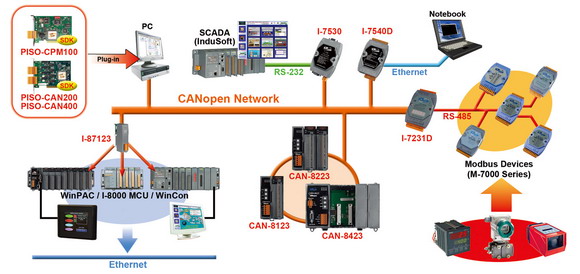
 CANopen Introduction CANopen Introduction  CANopen Solutions CANopen Solutions
|
|
|
|
|
| |
|
|
| |
|
|
| |
CANopen is a CAN-based application layer protocol. It was developed as a standardized embedded network with highly flexible configuration capabilities. CANopen was designed for motion-oriented machine control networks, such as handling systems. By now it is used in many various fields, such as medical equipment, off-road vehicles, maritime electronics, public transportation, building automation, etc.
The CANopen specifications cover application layer and communication profile, as well as a framework for programmable devices, recommendations for cables, connectors, SI units, and prefix representations. The application-layer as well as the CAN-based profiles are implemented in software.
CANopen features
- Allow multi-master architecture on one bus
- 10k,20k,50k,125k,250k,500k,800k,1M bps baud rate
- The bus length is from 25m(1M bps) to 5Km(10K bps)
- Easy access to all device parameters.
- Device synchronization.
- Cyclic and event-driven data transfer.
- Up to 128 nodes can be participated in the same CAN network.
- High transmission speed.
- Support Guarding and Heartbeat protection mechanism
|
|
| |
| |
INITIALISING |
PRE-OPERATIONAL |
OPERATIONAL |
STOPPED |
PDO |
|
|
X |
|
SDO |
|
X |
X |
|
Synchronisation object |
|
X |
X |
|
Time Stamp Object |
|
X |
X |
|
Emergency Object |
|
X |
X |
|
Boot-Up Object |
X |
|
|
|
Network Management Object |
|
X |
X |
X |
|
|
| |
CANopen Statue Transition
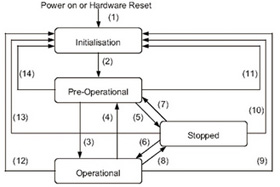 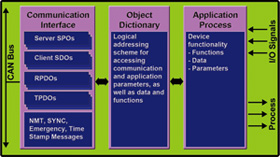
|
|
| |
|
|
|
|
|
| |
|
|
| |
|
|
| |
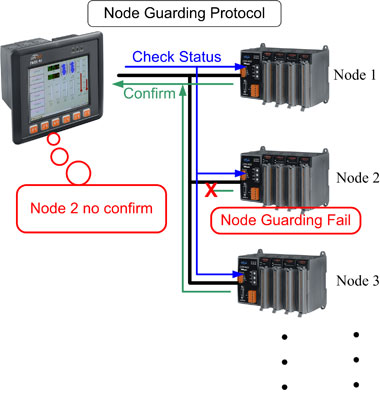 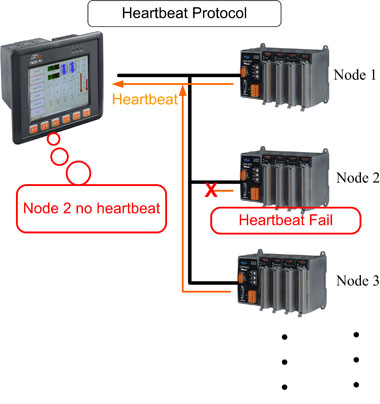
CANopen provides two network protection mechanisms, Node Guarding and Heartbeat. For Node Guarding, the master will send a request to check slave status. If some slave does not confirm this request, the master will indicate them with Node Guarding Fail. For Heartbeat, these slaves will send heartbeat message to the master let master know these slaves are alive. If the master does not detect some one’s heartbeat, then the master will indicate it with Heartbeat Fail.
|
|
| |
|
|
|
|
|
| |
|
|
| |
|
|
| |
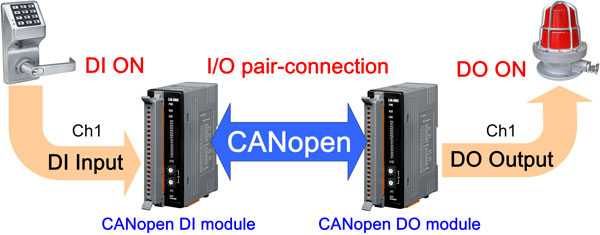
CANopen Digital I/O Pair-connection is a special function for CANopen remote I/O. It can send the DI value that is detecting by the CANopen DI Slave to others CANopen DO Slaves through the CANopen network, and then these CANopen DO Slaves will output the value. It is useful for users need to detect a DI signal and output a DO alarm at the same time.
|
|
| |
|
|
|
|
|
| |
|
|
| |
|
|
| |
CANopen Series Common Features
- Up to 128 nodes can be participated in the same CAN network
- CANopen Version: DS-301 v4.01
- Device Profile: DSP-401 v2.0
- Error Control: Node Guarding protocol
- Emergency Message: Yes
- 2500Vrms photo couple isolation on the CAN side
- Jumper or DIP switch for 120Ω terminator resistor of CAN bus
- Watchdog inside
|
|
| |
CANopen remote I/O unit series
CAN-8x23 series and CAN-2000C series are specially designed for combining sensors and actuators into CANopen network. They are standard CANopen slave devices which pass the validation of CiA CANopen Conformance Test tool, and all of them provide corresponding EDS file for standard CANopen master interface. The mainly differences between CAN-8x23 series and CAN-2000C series are the product size and the capabilities of expansion. CAN-8x23 series is useful for centralizing control system. It provides flexible I/O selections to match various applications. The character ‘x’ indicates how many expansion slots it has. Therefore, we provide CAN-8123/CAN-8223/CAN-8423 for 1/2/4 expansion slots. Each slot allows you plugging one I-8000/I-87K series I/O module to expansion I/O channels, and hot-swap technique is supported. CAN-2000C series is a palm-size stand-along CANopen slave device. It specially suits for distribution control system, and can be placed in a small space even in the case of machine. Besides, CAN-2000C series support I/O pair-connection. It is used to extend the distance of DI/DO signal. For more information about these devices, please refer to the following links.
CANopen Gateway series
The Modbus TCP/RTU and DCON protocol gateways are ready for users. The series can be used to integrate different protocol system. Users also easily update their old system to the CANopen system with the series. They are I-7231D, I-7232D, GW-7433D.
CANopen master series
CANopen master series are I-87123 for PACs and PISO-CPM100 for PC based. In the series, there is CANopen master kernel inside. So, they can be used in high performance system. For economical solution, we provide the PISO-CAN card with the CANopen master lib.
|
|
| |
|
|
|
|
|
| |
|
|
| |
|
|
| |
Product Name |
I-7565-CPM |
PISO-CPM100(U) |
PISO-CAN 200/400(U) |
PEX-CAN200i
(PISO-CAN200E) |
I-87123 |
Hardware |
On board CPU |
16-bit CPU
80M Hz |
16-bit CPU
80M Hz |
None |
None |
16-bit CPU
80M Hz |
Interface |
USB |
5 V / 3.3 V PCI bus |
5 V / 3.3 V
PCI bus |
x1 PCI Express bus |
I-87K Slot (WinPAC,ViewPAC) |
CAN
Connector |
9-pin D-Sub |
5-pin screw terminal
9-pin D-Sub |
5-pin screw terminal
9-pin D-Sub |
5-pin screw terminal
9-pin D-Sub |
5-pin screw terminal |
CAN
Controller |
SJA1000 |
CAN
Transceiver |
82C250 |
Isolation on
CAN |
2500 Vrms |
Terminator
Resistor |
Selected by jumper(120Ω) |
|
CANopen |
Protocol
Specification |
CANopen Standard -- CiA Draft Standard 301 |
Baud Rate
Selection |
Programmable |
Baud Rate |
10 kbps, 20 kbps, 50 kbps, 125 kbps , 250 kbps , 500 kbps, 800 kbps, 1000 kbps |
Maximum
Slave nodes |
127 Nodes |
PDO Function |
Support dynamic PDO function |
PDO Object |
Provide 20 RxPDO and 20 TxPDO object |
EMCY Message |
Save the least EMCY |
SDO Protocol |
Support Expedited SDO and Segment SDO protocol |
On Line
Edit Nodes |
Support adding or removing devices on line |
NMTError
Control |
Support Node Guarding Event |
|
Driver |
DLL |
Support |
OS Version |
Win 2K/XP |
Win 2K/XP |
Win 2K/XP,Linux |
Win 2K/XP,Linux |
Win CE 4/5/6 |
Development
Tool |
Visual C++ 6 , Visual Basic 6 , Borland C++ Builder , Delphi |
eVC++ 4 , VS .NET |
|
|
| |
|
|
| |
|
|
| |
|
|
|
|